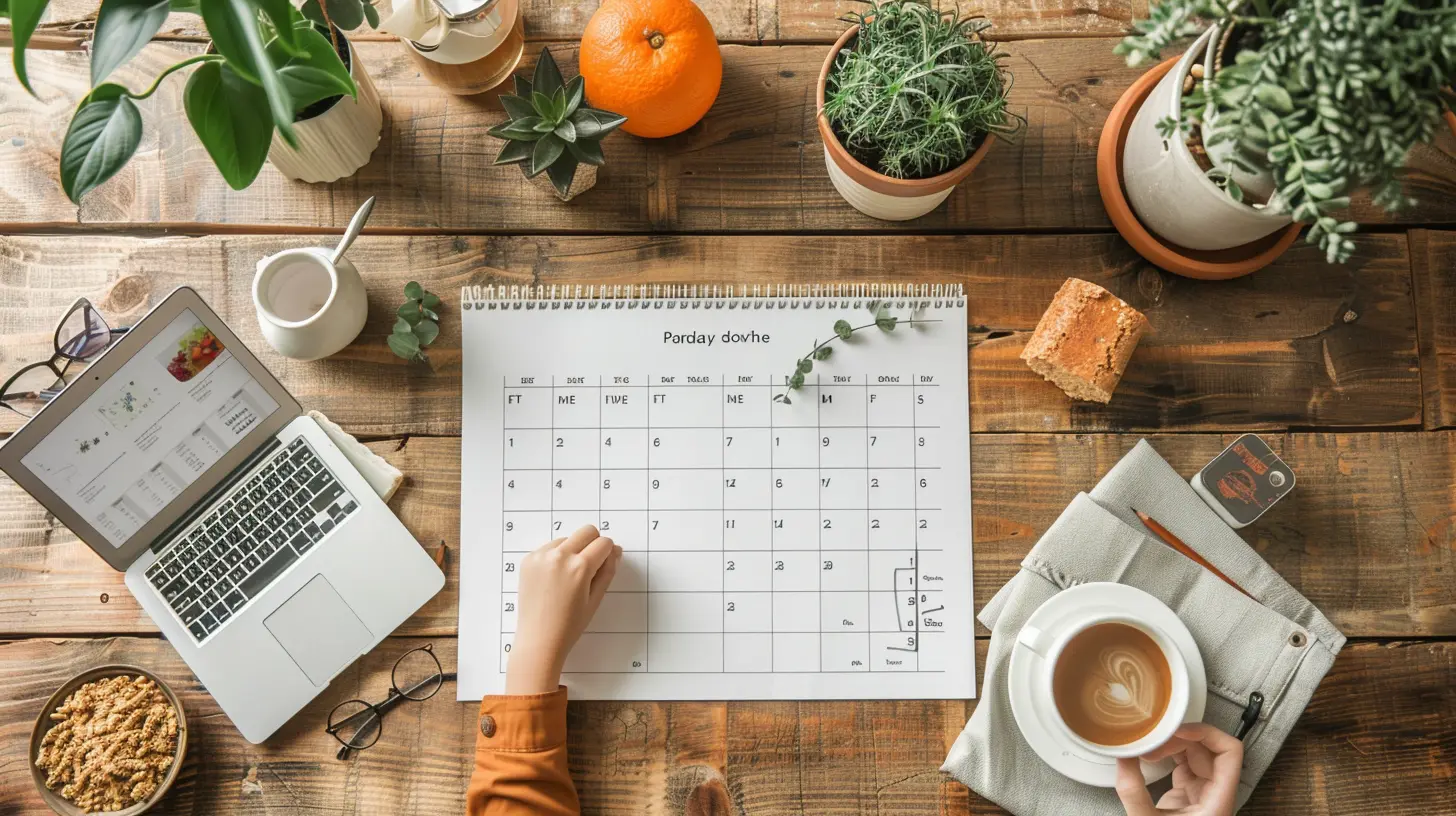How to Create A Productive Family Calendar
30 June 2025
Let’s be honest—family life is chaotic. Between soccer practices, school projects, grocery runs, dentist appointments, and that birthday party you swear wasn't on the radar until yesterday… it can all turn into a swirling mess. If your fridge is plastered with sticky notes and your phone alarms are going off like a fire drill, it’s time to get your family calendar game strong.
In this post, we're diving into how to create a productive family calendar that doesn’t just look good—but actually helps you stay sane. Whether you’re a color-coding wizard or a total newbie to the calendar game, I’ve got you covered.

Why You Really (Really!) Need a Family Calendar
Picture this: everyone knows what’s happening and when. No more missed ballet recitals. No forgotten science fair. No double-booked Saturday mornings. Sounds dreamy, right?A productive family calendar is more than just a list of to-dos—it’s your family’s communication hub, your schedule sanity-saver, and honestly, your secret weapon for smoother days.
So let’s build you a calendar that works harder than your morning coffee!

Step 1: Choose Your Calendar Style (Paper or Digital?)
First things first—what format works best for your crew?📔 The Classic Paper Calendar
There’s something satisfying about jotting things down with pen and paper. Hanging a wall calendar in a high-traffic area (like the kitchen) means everyone can see what’s coming up. Bonus points if it has magnetic backing for the fridge!Pros:
- Super visual
- No tech required
- Easy to engage kids (hello, sticker system!)
Cons:
- No automatic reminders
- Harder to change once things are written down
📱 The Digital Calendar Life
If your phone is basically an extension of your hand, a digital calendar might be your soulmate. Tools like Google Calendar, Cozi, or even shared Apple calendars can be synced across all devices.Pros:
- Instant updates for everyone
- Set reminders, alerts, and alarms
- You can color code and customize until your heart’s content
Cons:
- Needs active checking
- If someone doesn't have access, they’re out of the loop
Pro Tip: You don’t HAVE to choose just one. Use a combo! Maybe you keep the big picture stuff on the wall, and the nitty-gritty details in your digital calendar.

Step 2: Appoint the Chief Calendar Captain (Yes, That’s a Thing)
Every ship needs a captain, and every calendar needs someone to keep things on track. This doesn't mean you're stuck doing all the work—but it does mean you’re the keeper of the schedule.Usually, it’s the parent who’s the most organized (or, let’s be honest, the one who gets most stressed when things fall apart). Own that title! You’ve earned it.
Get input from the family, but make one person in charge of updates, reminders, and overall maintenance.

Step 3: Set a Weekly Family Calendar Meeting
Don’t worry, we’re not talking about corporate vibes here. This can be a 10-minute Sunday night chat around the dinner table or a quick Monday morning meeting before school.Here’s what to cover:
- Any unusual school events or activities this week?
- Any work schedule changes?
- Who’s got what and when?
- Rides needed? Meals planned?
Treat it like your weekly family GPS session. With everyone on board, you’re far more likely to avoid those “I didn’t know that was today!” meltdowns.
Step 4: Color Code Like a Boss
Color coding is calendar magic. It’s visual, quick to read, and kind of fun. Assign each family member a color and stick to it.For example:
- 🟢 Mom – Green
- 🔵 Dad – Blue
- 🟣 Emma – Purple
- 🟡 Jake – Yellow
- 🟠 Family events – Orange
Whether you’re using markers, stickers, or digital tags, this method makes it super easy to know who’s doing what with a single glance.
Step 5: Break It Down – Monthly, Weekly, and Daily
Your calendar should work in layers—kind of like a burrito (and who doesn’t like burritos?).Monthly View:
See the big events—vacations, doctor appointments, school breaks, birthdays. This is your zoomed-out lens.Weekly View:
Focus on the weekly rhythm—sports practices, recurring lessons, and errands.Daily Details:
Use this for the nitty-gritty stuff—“return library books,” “pick up cupcakes for school,” or “conference call at 3 PM.”Some digital calendars let you adjust your view with a tap—super handy on busy days!
Step 6: Don’t Forget the Fun Stuff!
A family calendar isn’t just about structure—it’s about making space for joy too.Add in:
- Movie nights
- Game nights
- Backyard BBQs
- Date nights (please don’t forget these!)
- Solo time for each parent or child (mental health matters!)
Fun gets overlooked when the calendar is only packed with obligations. Pencil in the good stuff, too. Your family will thank you for it.
Step 7: Use Reminders and Alerts (Your Future Self Will Love You)
Let’s face it—we’ve all missed something important because we meant to remember it. That’s why reminders are your best friend.Set digital alerts for:
- 1-day before the event (to prep)
- 1-hour before (to move your booty!)
Or if you’re rocking the paper route, use sticky notes or a daily checklist. Whatever helps jog your memory!
Step 8: Make It Kid-Friendly
Kids won’t use the calendar if it’s not fun or easy to understand. Use icons or stickers for younger kiddos—a soccer ball for practice, a book for reading time, or a cake for birthdays.And for older kids? Let them help! Teach them how to input their own events or check the schedule daily. It builds responsibility, plus they’ll stop asking you every 10 minutes what’s happening next.
Step 9: Sync with School and Activity Calendars
Be proactive. Most schools and extracurricular programs hand out monthly or semester schedules. Plug in important dates as soon as you get them.Bonus Tip: Print out PDF versions of these schedules and keep them in a clear folder by the calendar for easy reference.
Step 10: Review and Adjust (It's Not Set in Stone)
Life happens. Things get rescheduled. Kids get sick. Plans change.Your calendar should be flexible—like yoga flexible.
At the end of each week, take a few minutes to clean up the past week’s events, mark off what’s done, and prep for what’s next. This way, your calendar stays a living, breathing tool—not a forgotten relic buried under a pile of unpaid bills.
Real-Life Hacks from Other Parents
Here’s what some real-life calendar ninjas (aka parents like you) are doing:💡 “We have a family whiteboard near the exit door. Every Sunday, we write the week’s events. It’s simple, but we all see it before leaving the house.” – Carrie, mom of 3
💡 “Each Sunday, I text our extended family with a quick rundown of what our week looks like—it helps with coordination and babysitting.” – David, dad of 2
💡 “I use Cozi. I add meal planning, chores, and bedtime shifts. It’s a lifesaver for co-parenting!” – Jenna, mom & stepmom
Bonus Tip: Don’t Overcomplicate It
The best calendar is the one you’ll actually use. Don’t aim for Pinterest-perfect. Start simple and build up. You can always add bells and whistles later.Even a basic system can make a world of difference.
Final Thoughts: Your Calendar, Your Peace of Mind
Creating a productive family calendar isn't about being perfect—it’s about staying connected, reducing stress, and bringing a little more calm into your wonderfully wild household.Think of your calendar as your family’s shared life map. It won’t prevent every bump in the road, but it’ll definitely help you avoid the ditches.
So grab your markers or tap open that calendar app—because a more organized, less-stressed life is just one square block away.
all images in this post were generated using AI tools
Category:
Parenting ResourcesAuthor:

Kelly Snow
Discussion
rate this article
1 comments
Tatianna McTier
Creating a family calendar: because relying on our memories is like expecting a cat to fetch. Just stick to the plan and hope for the best!
July 6, 2025 at 3:31 AM

Kelly Snow
Great analogy! A family calendar is definitely the best way to keep everyone on track and avoid chaos.


